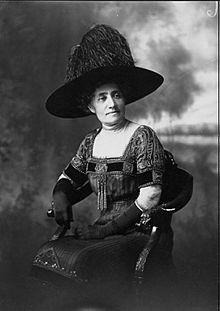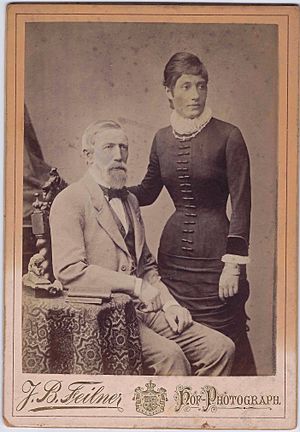Wilhelmine Kekelaokalaninui Widemann Dowsett facts for kids
Quick facts for kids
Wilhelmine Widemann Dowsett
|
|
|---|---|

Wilhelmine Dowsett, 1918
|
|
| Born |
Wilhelmine Kekelaokalaninui Widemann
March 28, 1861 |
| Died | December 10, 1929 (aged 68) |
| Resting place | Oahu Cemetery |
| Political party | Republican |
| Spouse(s) | John McKibbin Dowsett |
| Children | 3 |
| Parent(s) | Hermann A. Widemann Mary Kaumana Pilahiuilani |
Wilhelmine Kekelaokalaninui Widemann Dowsett (born March 28, 1861 – died December 10, 1929) was an important Native Hawaiian leader. She fought for women's right to vote. In 1912, she helped start the National Women's Equal Suffrage Association of Hawaii. This was the first club in Hawaii focused on getting women the right to vote. She worked hard to gain voting rights for women in Hawaii before a big change happened in 1920. This change was the Nineteenth Amendment to the United States Constitution, which gave all women in the U.S. the right to vote.
Contents
Early Life and Family
Wilhelmine was born on March 28, 1861, in Lihue, Kauai. Her father, Hermann A. Widemann, was a German businessman who moved to Hawaii. Her mother, Mary Kaumana Pilahiuilani, was Hawaiian. Her mother's family had connections to the aliʻi (chiefs) of Kauai. Wilhelmine's father was a well-known politician in the Kingdom of Hawaii. He even worked as a minister for the last queen, Liliʻuokalani.
On April 30, 1888, Wilhelmine married John "Jack" McKibbin Dowsett. His grandfather, Captain Samuel James Dowsett, had settled in Hawaii in 1828. Their wedding was a big event. Members of the Hawaiian Royal Family, including King Kalākaua and Queen Kapiʻolani, attended.
Her husband became a very successful businessman. He worked in banking, insurance, and the sugar industry. He also owned ships that traveled between the islands. He was a Republican Senator in the Hawaii government from 1905 to 1907. Wilhelmine and John had three children: Herbert, Frank, and Alice.
Fighting for Women's Voting Rights
After Hawaii became part of the United States, Wilhelmine became a key leader in the movement for women's right to vote. In the early 1900s, women in nearby states like California and Oregon gained the right to vote. This made people in Hawaii more interested in the idea.
In 1912, women in Honolulu asked Dowsett to help them. She then started the National Women's Equal Suffrage Association of Hawaii (WESAH). This was Hawaii's first group dedicated to women's voting rights. The group wanted to be called "suffragists." They did not want to be called "suffragettes," which was a term sometimes used for more aggressive groups in Britain.
Wilhelmine was the president of WESAH. The group's rules were based on a similar national organization. A famous leader from the mainland, Carrie Chapman Catt, visited Hawaii in 1918. She spoke to the group and helped grow interest in their cause. The Honolulu Star-Bulletin newspaper wrote about the excitement:
The Hawaiian women are eager to vote and will do all they can to get equal suffrage. One member said that Hawaiian women didn't know how to start before. But with Mrs. Dowsett as president, they feel their cause will move forward. All members want to be active and get all women in the city interested, no matter their background.
Wealthy women of Native Hawaiian or mixed Hawaiian and European backgrounds, like Dowsett, were early leaders. Some Euro-American women were less supportive. They worried about more non-white women being able to vote.
In 1913, Dowsett spoke at a meeting with politicians. She argued that women were just as smart as men, or even smarter. She said:
I can speak for my Hawaiian sisters. I can say that women are better than men in many ways. A woman will vote just as wisely, and she will vote honestly. No amount of money could buy her vote. And on a jury, she will make smart decisions. There will be no doubt about her choice.
A big problem for women's voting rights in Hawaii was the Organic Act. This law created the Territory of Hawaii. It specifically stopped the local government from giving women the right to vote. This was different from most other states. But with help from leaders on the mainland, Hawaiian suffragists worked to change this. They pushed for a new law in Congress that would let Hawaii decide on the issue.
In 1919, a bill to give women the vote was discussed in Hawaii's government. The Senate approved it, but the House of Representatives disagreed. They couldn't agree on whether the bill would start in 1919 or 1920. On March 6, 1919, Dowsett called a large meeting of WESAH women. They demanded the right to vote in the upcoming elections.
The House then suggested a different bill. This bill would delay the issue even more. On March 23, Dowsett and Louise MacMillan, another WESAH leader, gathered nearly 500 women. These women were from different backgrounds and ages. They marched into the House, carrying a large sign that said "Votes for Women." The next day, the House held a meeting about women's voting rights. Dowsett and MacMillan also held a big gathering at ʻAʻala Park. They wanted to get more people to support their cause. Many important women spoke there, including Princess Elizabeth Kahanu Kalanianaʻole and Mary Dillingham Frear.
Dowsett traveled to other Hawaiian Islands to gain more support. However, the bill never passed in Hawaii. This was because in 1920, the U.S. Congress passed the Nineteenth Amendment. This amendment gave all women across the United States the right to vote.
Helping During Wartime
During World War I, Wilhelmine Dowsett led the Hawaiian Knitting Unit. This group started in March 1918. Her sister, Emilie Widemann Macfarlane, and friend, Emma Ahuena Taylor, also helped organize knitting groups. These groups made items for Native Hawaiian soldiers and service members fighting overseas. Historians believe that Native Hawaiians of German descent, like Dowsett, felt pressure during the war. They had family ties to Germany, which was an enemy of the U.S. They also had been involved in past actions against Hawaii becoming part of the U.S. So, they focused their efforts on helping Hawaiian soldiers.
Death and Legacy
Wilhelmine Dowsett passed away in Honolulu on December 10, 1929. This was shortly after her husband died in September of the same year. She had been unwell for about a year before her death. After a private funeral, her ashes were buried next to her husband at the Oahu Cemetery. Her grave marker shows her name as "Wilhelmine Widemann Dowsett."
In 2020, Wilhelmine Dowsett was honored by the National Women's History Alliance. This group recognizes women who have made important contributions to history.


